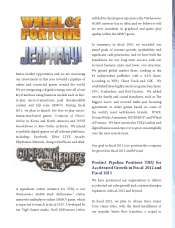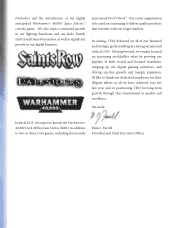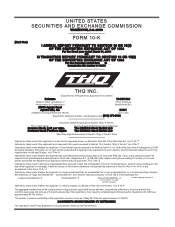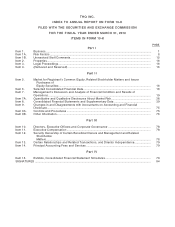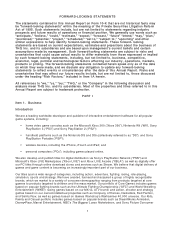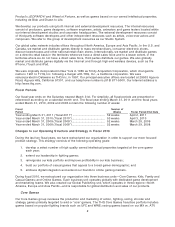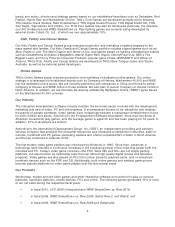THQ 2010 Annual Report Download - page 15
Download and view the complete annual report
Please find page 15 of the 2010 THQ annual report below. You can navigate through the pages in the report by either clicking on the pages listed below, or by using the keyword search tool below to find specific information within the annual report.7
Plat form License Agreements
Before we can develop, market, or sell video games on a console or handheld platform, we must enter into a
license agreement with the manufacturer of such platform. The current “platform manufacturers” are Microsoft,
Nintendo and Sony. Each of these platform license agreements allows us a non-exclusive right to use, for a
fixed term and in a designated territory, technology that is owned by the platform manufacturer in order to
publish our games on such platform. We are currently licensed to publish, in most countries throughout the
world, titles on Xbox 360; PS3, PS2, and PSP; and the Wii and DS. Additionally, we are authorized to
develop and publish online content compatible with each console that utilizes online content. As each
platform license expires, if we intend to continue publishing games on such platform, we must enter into a
new agreement or an amendment with the platform manufacturer to extend the term of the agreement.
Certain agreements, such as the licenses with Sony for the PS3 and PS2 and with Microsoft for the
Xbox 360, automatically renew each year unless either party gives notice by the applicable date that it
intends to terminate the agreement.
Our platform licenses require that each title be approved by the applicable platform manufacturer. The
platform manufacturers have the right to review, evaluate and approve a prototype of each title and the title’s
packaging and marketing materials. Once a title is developed and has been approved by the platform
manufacturer, except for online content, the title is manufactured solely by such platform manufacturer or its
designated vendor. The licenses establish the payment terms for the manufacture of each cartridge or disc
made, which generally provide for a charge for every cartridge or disc manufactured, and also establish a
royalty rate for delivery of online content compatible with such manufacturer’s platform. The amounts charged
by the platform manufacturers for both console discs and handheld cartridges include a manufacturing,
printing and packaging fee as well as a royalty for the use of the platform manufacturer’s name, proprietary
information and technology, and are subject to adjustment by the platform manufacturers at their discretion.
The platform license agreements also require us to indemnify the platform manufacturers with respect to all
loss, liability and expense resulting from any claim against the platform manufacturer involving the
development, marketing, sale, or use of our games, including any claims for copyright or trademark
infringement brought against the platform manufacturer. Each platform license may be terminated by the
platform manufacturer if a breach or default by us is not cured after we receive written notice from the
platform manufacturer, or if we become insolvent. Upon termination of a platform license for any reason other
than our breach or default, we have a limited period of time to sell any existing product inventory remaining
as of the date of termination. The length of this sell-off period varies between 90 and 180 days, depending
upon the platform agreement. We must destroy any such inventory remaining after the end of the sell-off
period. Upon termination as a result of our breach or default, we must destroy any remaining inventory within
a minimum number of days as specified by the platform manufacturer.
Seasonality and Deferral of Revenue
The interactive entertainment software industry is highly seasonal, with sales typically significantly higher
during the third quarter of our fiscal year, due primarily to the increased demand for interactive games during
the year-end holiday buying season.
Net sales are impacted by the deferral and/or recognition of revenue from the sale of titles for which the
online service is more-than-inconsequential to the overall functionality of the game and as such represents a
deliverable. Such deferrals are recognized ratably over the estimated service period of six months beginning
the month after initial sale.
Major Cus tomers
Our largest customers worldwide include Best Buy, GameStop, Target and Wal-Mart. We also sell our
products to other national and regional retailers, discount store chains, specialty retailers and distributors.
GameStop and Wal-Mart each accounted for more than 10% of our gross sales in fiscal 2010. We have two
“Vendor” agreements with Wal-Mart (one for our console products and one for our PC products) that we
entered into in 2001 and 2002, respectively, that address certain standard terms and conditions, such as
payment terms, between us and Wal-Mart; however, the agreements do not contain any commitment for Wal-
Mart to purchase, or for us to sell, any minimum level of products. We do not have any agreements with
GameStop. With respect to both Wal-Mart and GameStop, as well as our other customers, the customer
submits a purchase order for each purchase request, and that purchase order contains basic pricing and
delivery terms for such purchase. None of the purchase orders individually, with any customer, accounted for


